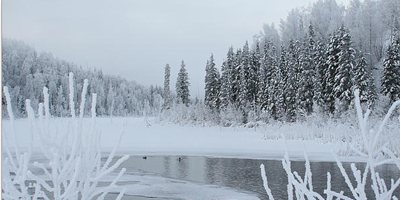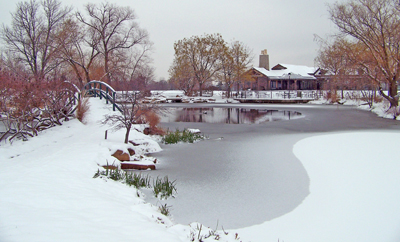Aquatic life in winter
What is happening under the ice in your pond?
 What a contrast to the colors and the life that animates a pond in other seasons of the year; one would think that in the winter the pond is asleep and all life is gone. Yet think again, even if it is slowing down, the activity under the ice does not stop despite the cold weather settling in. Millions of bacteria are attempting to reduce, transform and digest large amounts of organic matter accumulated after the leaves have fallen and aquatic plants have died.
What a contrast to the colors and the life that animates a pond in other seasons of the year; one would think that in the winter the pond is asleep and all life is gone. Yet think again, even if it is slowing down, the activity under the ice does not stop despite the cold weather settling in. Millions of bacteria are attempting to reduce, transform and digest large amounts of organic matter accumulated after the leaves have fallen and aquatic plants have died.
Some of these bacterial organisms can work anaerobically, that is to say, without oxygen, but most need oxygen to live and consume a significant amount of organic matter. Thus, the available oxygen in the aquatic environment is gradually depleted, while the exhaust gases produced in the process of digestion accumulate under the ice and degrade the water quality of the pond. It is this period that seems so quiet when we look at the snow that accumulates on the surface of the pond, which proves to be the most critical (or deadly) period of the year for fish. Indeed, in the absence of ice, the air which naturally mixes or oxygen added through plant processes contains 21% oxygen and can diffuse to the surface of the water, allowing fish to find oxygen-rich water through the water column. But in winter, ice forms an insulating layer that prevents any transfer of gases either by adding oxygen from wind or releasing carbon dioxide (produced by cellular respiration) to the air. The lack of light also stops photosynthesis of the remaining plants, further preventing oxygen production at a time of continued decomposition.
 Now we understand the importance of aeration during the winter season. Indeed, while maintaining a sufficiently large level of dissolved oxygen so that the entire water column and its occupants benefit, the system of air diffusion at the bottom of the pond can provide all the fuel for bacteria to do their job. Also, on its way back to the surface, the air causes water circulation and keeps an opening for the exchange of gases.
Now we understand the importance of aeration during the winter season. Indeed, while maintaining a sufficiently large level of dissolved oxygen so that the entire water column and its occupants benefit, the system of air diffusion at the bottom of the pond can provide all the fuel for bacteria to do their job. Also, on its way back to the surface, the air causes water circulation and keeps an opening for the exchange of gases.
Thus, it is best to keep the compressor on during the cold season. However, once the temperature goes down below zero degrees Celsius, you will have to choose between your recreational activities on the lake or aeration. Before you lace up your skates and invite your neighbours for a little hockey game, or before leaving at the crack of dawn with your fishing rod & auger in hand, make sure that the ice has sufficiently hardened for you venture on it. Check with local authorities, but generally 5” or 12cm of ice is safe for walking on, so long as the ice has frozen hard without periods of above zero C temperatures that can degrade the thickness of winter ice.
As described above, the aeration system maintains an open hole in the ice, decreasing its thickness and thus weakening its strength. So if you plan to go about your favourite winter activities, turn off the compressor at least two weeks before going on the lake, and make sure the ice is strong enough before you walk on it. As soon as the temperature rises and your skates have found their place at the bottom of the closet, turn on your compressor and the hole will reappear.
Also, if snowmobiles, hikers, snowshoer or dog sled teams go on your lake, it is best to put up a sign near the air diffuser stations to avoid any accidents or unpleasant surprises. Finally, the owners of water gardens with fish in them should also be familiar with the concept of aeration in the winter to keep their little friends healthy. Winter aeration for ponds makes sense!
Related Articles: